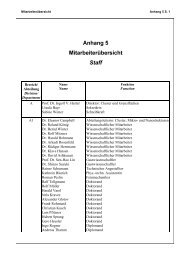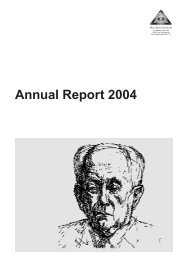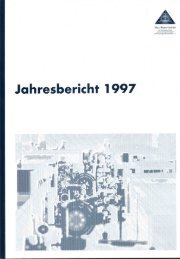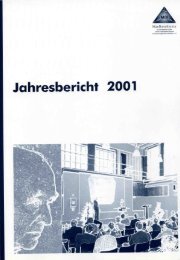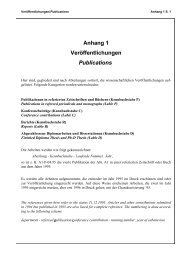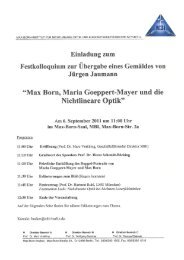You also want an ePaper? Increase the reach of your titles
YUMPU automatically turns print PDFs into web optimized ePapers that Google loves.
Not shown in Fig. 9 is that those electrons that re-collide early in the pulse (for example about<br />
1 femtosecond after ionization) have low velocity (long wavelength). Those that re-collide near<br />
the peak of the pulse (about 1.7 femtoseconds) have high velocity (shorter wavelengths).<br />
Those that re-collide after the pulse peak (for example about 2.5 femtoseconds) have longer<br />
wavelengths again. It is this well-confined re-collision, combined with the energy sweep that<br />
accompanies it, that ultimately allows us to produce attosecond pulses.<br />
We have already shown that when intense laser pulses ionize atoms or molecules, an electron<br />
interferometer is naturally formed. To use the interferometer to characterize the waves, we<br />
must find a way to “see” the interference.<br />
Figure 10 (which is a three-dimensional version of Fig. 7) concentrates on the region where the<br />
re-collision electron and the initial wavefunction overlap. This is where the interference actually<br />
occurs. The wave in blue on the top left and right images represents the re-collision electron.<br />
It looks like a uniform wave passing over the initial wave function. The left and right<br />
images represent the wave at two closely spaced instants. In Fig. 10, the re-collision wave has<br />
advanced by 1/2 wavelength between the two images.<br />
When waves interfere, we add the overlapping components of the wave – in this case, the recollision<br />
wave packet and the bound-state wave function. (The same things happen in a swimming<br />
pool when the wave packets created by two divers meet.) The upper images contain this<br />
addition. The biggest peak on the sum wave moves from one side of the atom to the other<br />
between the two images. We highlight this in the colour coding.<br />
<strong>Max</strong> <strong>Born</strong> taught us that the square of the image represents the probability of finding the electron<br />
in any region of space. The square of the wave function is shown on the middle image.<br />
The bottom images are two-dimensional projections of the 3-D images in the middle frames.<br />
They are included as an alternative (and perhaps easier) way to visualize the process.<br />
The middle images or their 2-D projections show that interference between the bound and<br />
the re-collision electron transfers the charge from left to right. This rapid oscillating motion<br />
continues as long as the re-collision lasts. The faster the re-collision electron moves, the faster<br />
the oscillation.<br />
An oscillating charge produces radiation at the frequency of the oscillation. Observing this light<br />
solves our third challenge – “how to read the interference pattern.” Scientists have known for<br />
some time that gases of ionizing atoms produce extreme ultraviolet light. Since 1993, it has<br />
been known that re-collision explained the physics that underlies this light source [9]. Thus,<br />
Fig. 8<br />
An optical interferometer is<br />
compared with the laser<br />
induced electron re-collision.<br />
Recording the electron<br />
interference<br />
Measuring the interference<br />
– High harmonics<br />
and attosecond<br />
optical pulses<br />
<strong>Max</strong> <strong>Born</strong> • Paul Corkum 39



